Arana, Alfonso - VM - Sandra Bowden
Alfonso Arana: Anunciación

The Veil
by Sandra Bowden
Alfonso Arana has given us a most intriguing Annunciation. The angel looms large approaching Mary who is kneeling while peeling away a thin veil from her face and her body. What could this mean?
In Christian tradition the veil was a symbol of dignity, chastity and virginity. The history and meaning of wearing a veil, especially the wedding veil which we are most familiar with, dates back to ancient times when unmarried women wrapped themselves, sometime head to toe, to identify as a virgin. To this day many brides wear a veil as they approach their groom for marriage.
The Bible has numerous instances where veils are mentioned. In the Old Testament the veil was the boundary between heaven and earth. Both in a physical and spiritual sense the veil represented the passage into the Holy of Holies. Ancient Israel’s tabernacle had a veil of thick purple, blue and scarlet materials, separating the Holy Place from the Holy of Holies. It was a doorway to the presence of God into which only the high priest could enter.
The New Testament tells us that Jesus’ body veiled his deity. Hebrews 10:19-20 tells us that this veil was rent in two at the crucifixion. “Therefore, brothers and sisters, since we have confidence to enter the Most Holy Place by the blood of Jesus by a new and living way opened for us through the curtain (veil) that is his body.” Paul says, “But whenever a person turns to the Lord, the veil is taken away,” allowing us to have access to God (II Corinthians 3:16).
There is a medieval tradition that Mary wore a veil at the time of the Annunciation. Alfonso Arana is aware of this convention as he pictures Mary removing a thin veil, not only from her face, but from her whole body as she accepts what the Angel has told her, that she is to bear the Son of God. She offers herself, her body, to birth the one who will abolish the veil that separates us from God, breaking the boundary between heaven and earth.
Each of these insights help expand our understanding of the Annunciation and Incarnation in new ways as we celebrate the birth of Jesus.
*******
Alfonso Arana: Anunciación, lithograph, 100 x 76 cm.
Alfonso Arana (1927 – 2005) is a Puerto Rican artist who created many biblical subjects, especially those that related to Mary and Mother and Child themes. He studied art in Mexico at the Atelier de Jose Bardasono, the Manhattan School of Arts in New York, the Académie Julian and L’Ecole des Beaus-arts of Paris, and did post graduate work at the American University in Washington, D.C. He exhibited his work in Tokyo, Paris, New York, Mexico City, Spain and Puerto Rico.
Of his art, Arana said:
My figures have the elements of life and light. That light that invades the body is the spiritual side of these beings and I like painting in that spiritual space. Each figure transcends life beyond real life and I feel the beings come from within me and then I, myself become part of their world. They are real to me, they are my friends.
Sandra Bowden is a painter and printmaker with over 100 solo exhibitions. She is a passionate collector of religious art and curates exhibitions that travel nationally from her collection. Sandra was president of CIVA (Christians in the Visual Arts) and trustee of the MOBIA (Museum of the Bible in Art). She studied at Massachusetts College of Art and received her BA from the State University of New York. For more information on Sandra Bowden go to www.sandrabowden.com and www.bowdencollections.com
ArtWay Visual Meditation Christmas 2022


